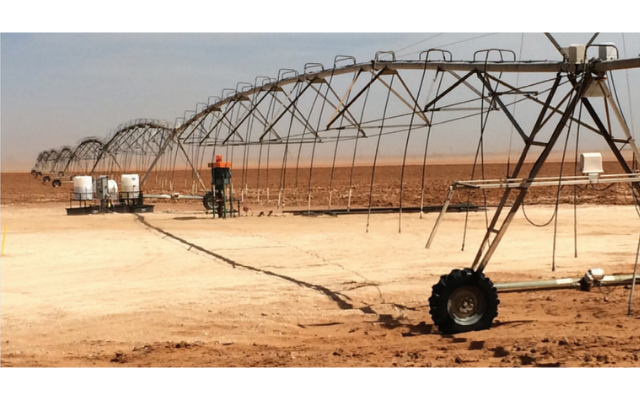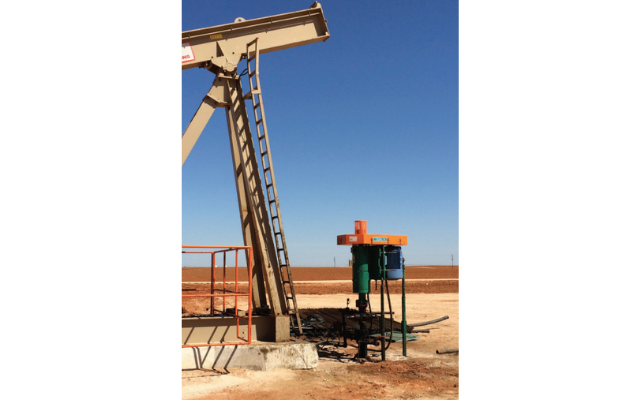Low profile and low cost solution solves customer problem in an irrigated cotton field
The oil-and-gas-abundant landscape of West Texas is dotted with rigs and production systems. In the Permian Basin, not far from the Midland-Odessa hub, oilfields and farms co-exist subsequently requiring creative machinery solutions to meet both industry needs.
A local West Texas energy company, called on NETZSCH to install pumps for an Artificial Lift system in a cotton field that had height restrictions. The irrigation pivot had to pass overhead, so the maximum height profile of the pumping system had to allow sufficient clearance. The customer was seeking an option that would meet the height criteria and also provide the operating performance to deliver 500 barrels of fluid per day along with varying amounts of gas.
Among the options, an Electric Submersible Pump (ESP) could provide the flow rate and meet the height limitation, but the cost was prohibitive. A Strap Jack cost slightly less than the ESP, and while it had a low profile, it could not deliver the required flow rate. The NETZSCH Progressing Cavity Pump offered the best alternative since it met the flow and height requirements and was less expensive than the other pump types but there were other factors to consider as well.
The first major challenge was the handling of the Frac Sand from the reservoir that found its way into the wellbore. Most types of pumps are not able to handle minimal amounts of sand and would lock up. Progressing Cavity Pumps are a better solution, but if not sized correctly, the higher volume of sand could also be problematic. In general, about 10% of sand by volume of the flow rate would be considered very severe. In West Texas installations, it is not uncommon to find the volume of sand as high as 30% in wells that require hydraulic fracturing.
The presence of such high volumes of sand, not only impedes the flow rate, consequently reducing the production, but also causes excessive wear on the entire pump system. NETZSCH engineers by calculating the operating conditions and selecting superior materials for the rotor and stator, were able to solve this problem.
Based on the well depth, the pressure capability required from the pump was 2200 psi. The speed selection was critical to ensure maximum flow rate and to achieve a sufficiently high fluid velocity through the tubing to remove the Frac Sand.
Since the Well Casing was 5-1/2 inch diameter, a 4-inch diameter NETZSCH Single Lobe downhole pump NTZ400*150ST33 was selected as an efficient solution to create the optimum operating conditions.
The pump is rated for 200 equivalent barrels per day at 100 rpm. During the initial stage, however, the pump must produce 600 equivalent barrels per day in order to move the high volumes of Frac Sand and Frac Water. Over time, as the well gets cleaned out and the Frac Water is eliminated, the pump speed has to be turned down to adjust to the reduced flow rate which could be as low as 200 equivalent barrels per day.
(NETZSCH also manufactures multi-lobe downhole pumps for the same flow rates in smaller diameters suitable for 4-inch casing.)
A 75 horsepower NETZSCH Drive Head NDH075DH33 with a 33,000 pound axial load capacity, and a hydraulic brake system complies with the low height restriction.
The second major challenge was the presence of high volumes of gas. In almost every well, the flow rate is not uniform, and the percentage of gas and liquids can vary significantly. In this particular oil field, the percentage of gas was varying from a minimum of 30% to almost 97%. These dramatic changes can lead to the phenomenon of slugging, which can result in stator overheating which is detrimental to the pump.
 Along with this, the gas contained Hydrogen Sulfide, which is extremely toxic and can be deadly even in small quantities. It was not only present, but would spike as high as 6 to 8% for short durations. In these circumstances, along with damage to the stator, even the metal parts can be impacted via hydrogen embrittlement. Overall the integrity and reliability of the pump were a concern from a safety standpoint.
Along with this, the gas contained Hydrogen Sulfide, which is extremely toxic and can be deadly even in small quantities. It was not only present, but would spike as high as 6 to 8% for short durations. In these circumstances, along with damage to the stator, even the metal parts can be impacted via hydrogen embrittlement. Overall the integrity and reliability of the pump were a concern from a safety standpoint.
The third challenge also required a material solution. West Texas Oil is generally light, and in this application the specific gravity was 40 API. When the oil is very light in excess of 36 API, the chemical composition of the oil can create a problem with elastomers, so this imposed additional criteria for the selection of the materials for the parts that would come in contact with the oil.
The customized elastomeric stator material that NETZSCH could provide was able to handle high temperature applications, for the variable flow and fluctuating gas volumes. The elastomer choice was instrumental in ensuring the pump integrity.
Ths complex application was further complicated by the extreme conditions encountered during the operating cycle. Each one of the critical characteristics is normally challenging, so to design a system that would be an optimum solution for three variables simultaneously was a great achievement.
With the NETZSCH Pump System, in severe conditions, the service life has exceeded 18 months. The Field Supervisor operating this project for the customer is very satisfied with the performance of the NETZSCH Progressing Cavity pump and continues to install additional systems at more wells.




